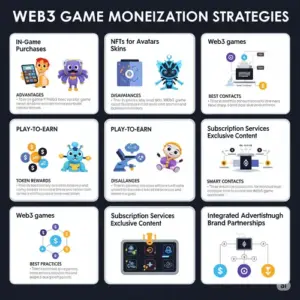Learn how to ethically monetize your Web3 game in Bangladesh. Focus on sustainable strategies like royalties & subscriptions, avoiding gambling mechanics.

Sustainable Economies: Ethical Monetization Strategies for Web3 Game Developers
Hey everyone, Troy here again from 7xmbangladesh.com!
We’ve been talking a lot about building awesome Web3 games, and today I want to focus on something super important for app owners and developers: how to make money from your game in a way that’s fair, sustainable, and doesn’t feel like gambling.
We all know that selling NFTs (Non-Fungible Tokens) can be one way for Web3 games to earn revenue. But guess what? It’s not the only way, and sometimes relying too much on just selling NFTs can be risky and not very stable in the long run.
So, let’s dive into some other cool and ethical ways you can monetize your Web3 game and build a healthy, thriving economy that benefits both you and your players right here in Bangladesh. If you’re curious about who I am and my passion for gaming, feel free to read more on my About Troy Dela Cruz page.
Moving Beyond Speculation: Building Real Value
The key to sustainable monetization in Web3 games is to focus on providing real value to your players, not just hoping they’ll buy something because it might be worth more later. Think about how traditional games make money – it’s often through things that enhance the player’s experience. We can bring some of those ideas into the Web3 world in smart ways.
1. Royalty Fees on NFT Trades: Earning with Every Transaction
Imagine every time one of your players buys or sells an NFT from your game on a marketplace, your game earns a small percentage. That’s a royalty fee.
How it works: When you create your game’s NFTs using smart contracts, you can program in a royalty percentage. So, if a player sells a rare sword NFT for 100 tokens, and your royalty is 5%, your game automatically receives 5 tokens.
Why it’s good:
- Passive Income: You earn a small amount whenever your in-game assets are traded.
- Aligns Incentives: Your success is tied to the activity and value within your game’s economy.
- Not Gambling: It’s based on player-driven trading of owned assets.
Think about it: If your game has a vibrant player economy with lots of trading, these small fees can add up over time.
2. Subscription Models: Offering Premium Perks
Just like many online services, you can offer players a subscription for a recurring fee (maybe monthly). In return, subscribers get access to special benefits that enhance their gameplay but don’t break the balance for non-subscribers.
Examples of Subscription Perks:
- Exclusive Content: Access to unique quests, areas, or storylines.
- Bonus Rewards: Earn more tokens or resources for completing in-game activities.
- Cosmetic Items: Special skins or visual upgrades for their characters or items.
- Early Access: Get to try new features or content before everyone else.
- Reduced Fees: Lower transaction fees within the game.
Why it’s good:
- Predictable Revenue: Subscriptions provide a more stable and predictable income stream.
- Player Loyalty: Encourages players to stay invested in your game long-term.
- Not Gambling: Players know exactly what they’re paying for and what benefits they’ll receive.
Consider: What kind of exclusive content or benefits would your Bangladeshi players find valuable enough to subscribe to?
3. Carefully Integrated In-Game Advertising: Reaching a Wider Audience
Advertising can be another way to generate revenue, but it needs to be done thoughtfully so it doesn’t annoy players or disrupt their experience.
How to do it well in Web3:
- Non-Intrusive Ads: Think of subtle placements, like advertisements on virtual billboards in a city within your game world.
- Opt-In Ads: Players could choose to watch a short ad for a small in-game reward.
- Partnerships: Collaborate with relevant brands to offer in-game integrations that feel natural to the game’s theme.
Why it can be good (if done right):
- Diversifies Revenue: Reduces reliance on direct player spending.
- Potential to Reach Non-Paying Players: You can still earn from players who don’t buy NFTs or subscriptions.
Be careful: Too many ads or poorly placed ads can frustrate players and make them leave your game. Always prioritize the player experience. If you’re interested in advertising opportunities with us, please visit our Advertise With Us page.
4. Skill-Based Tournaments with Entry Fees: Rewarding Competition
If your game has competitive elements, you can host skill-based tournaments where players pay a small entry fee to participate. The winners then receive a prize pool made up of the entry fees (minus a small cut for the game).
Why it’s good:
- Rewards Skill: Focuses on rewarding player ability and strategy, not luck.
- Creates Excitement: Fosters a competitive community.
- Generates Revenue: Entry fees provide a direct source of income.
Important Note: Make sure these tournaments are truly based on skill, not chance. The outcome should depend on the players’ abilities. This is very different from gambling where the outcome is random. We at 7xmbangladesh.com are committed to Responsible Gaming and emphasize skill over chance.
5. In-Game Services: Providing Convenience and Enhancements
You can offer various in-game services for a fee that make the player’s life easier or enhance their experience without being essential for basic gameplay.
Examples of In-Game Services:
- Speeding Up Processes: Players might pay a small fee to instantly finish crafting an item or travel to a distant location.
- Customization Options: Offering premium character customization options or unique building designs for virtual land.
- Convenience Features: Providing extra storage space or other quality-of-life improvements.
- Mentoring or Coaching Services: Experienced players could offer their services for a fee, with the game taking a small commission.
Why it’s good:
- Provides Utility: Players are paying for convenience or personalization.
- Doesn’t Create Pay-to-Win: These services should not give players an unfair advantage in core gameplay.
- Not Gambling: Players know exactly what they are purchasing.
What to Avoid: Gambling-Like Mechanics
It’s crucial to steer clear of monetization methods that resemble gambling, as this can be harmful and against the spirit of building a sustainable and ethical Web3 game.
Things to avoid:
- Loot Boxes with Random Rewards: These are very similar to slot machines where players pay for a chance to win something valuable. The odds are often hidden, and it can encourage addictive behavior.
- Purely Speculative Assets with No In-Game Utility: If the only reason an NFT has value is because people hopeits price will go up, it can create a bubble and doesn’t contribute to a healthy game economy.
- Mechanics That Prey on Chance or Addiction: Any system designed to exploit players’ desire for quick wins or encourage excessive spending based on luck should be avoided.
Building a Strong Economy for 7xmbangladesh.com Users
As you can see, there are many exciting and ethical ways to monetize your Web3 game. The best approach will likely involve a mix of these strategies, tailored to your specific game and your audience here in Bangladesh.
Remember to always be transparent with your players about how your game makes money. Focus on creating a fun and engaging experience first, and then think about how to build a sustainable economy that rewards both your hard work and your players’ participation. Always review our Terms and Conditions and Privacy Policy for our site’s guidelines. Please also be aware of our Disclaimer and Affiliate Declaration for full transparency.
What are your thoughts on these monetization models? Are there any other ethical strategies you’ve seen in Web3 games? Share your ideas in the comments below! If you have any questions or just want to chat, feel free to Contact Us.

Want to know who’s writing those game reviews? That’s me, Troy Dela Cruz! For the past three years, I’ve been working as an iGaming writer and reviewer. My main goal is to help you understand the world of online gaming better. I look at games, betting sites, and all the new things happening in iGaming. I try to give you honest opinions so you can choose what’s best for you.
When I’m not busy with iGaming, I’m often playing MOBA games. These are my favorite because they need good plans and teamwork. It’s always exciting to play with friends and try to win the game!
Come join me as I keep exploring the big world of online games, both as a writer and as a player!
